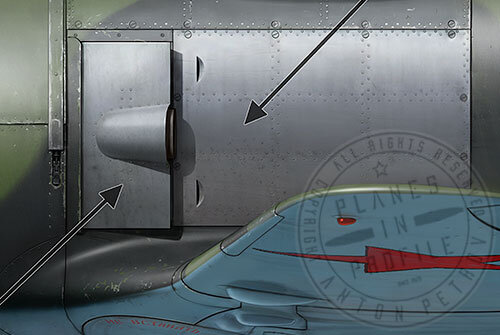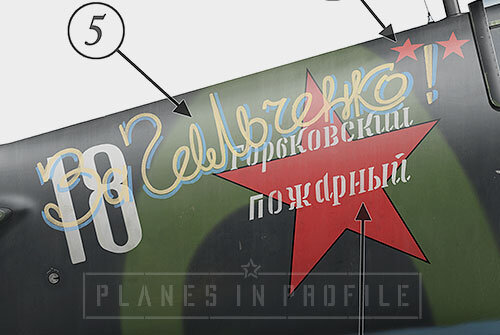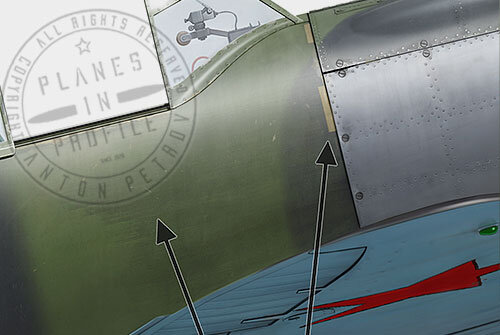Devyatkin’s White-18 “Za Gal’chenko!”
LAVOCHKIN, LA-5 (TYPE 37)
21-st IAP, 3-rd Air Army, Kalininskiy Front, possibly late June/July 1943, circa north of Smolensk (Russia)
Flown by the commander of a flight of 21-st IAP, leutenant Nikolay Dmitrievich Devyatkin.
Nikolay Devyatkin was a graduate of Borisoglebsk’s school for military pilots and like many talented students, he spent some time working there as an instructor after graduating. His participation in WW2 began on the 04-th of April 1943, and he started flying combat sorties from 9-th of May 1943, on the day of his 23-rd birthday. 21-st IAP was flying La-5 airplanes by this time, they flew them in combat starting from April 1943.
In June 1943, leutenant Devyatkin was a commander of a flight. By this time he scored 2 air victories, one shared and one personal. The last of these was scored on the 30th of May when he downed a FW-189. That same day, his friend and a fellow pilot by the name of Leonid Romanovich Galchenko, died in an air battle. This event prompted the desire to have Devyatkin’s La-5 inscribed with the words ‘For Galchenko!’ - a simple message of vengeance to the Germans.
On the 25th of June 1943 Devyatkin was awarded an Order of the Red Banner (O.R.B). The two photos we have of Devyatkin with the White-18 have Nikolay wearing this O.R.B. medal, which means that the photos must have been taken at some stage after the 25th of June, in other words - no less than 25 days after Galchenko’s death.
Devyatkin avenged for the death of his friend over the next few months as he shot down three more enemy airplanes, two in August and one in September. Thus by mid-September 1943, his victory score stood at 5 planes destroyed. These victories were:
29.05.1943 1 FW-189 (shared)
30.05.1943 1 FW-189 (personal)
24.08.1943 2 Ju-87 (shared)
15.09.1943 1 FW -190 (personal)
On the 18th of Feb 1944 Devyatkin took of on a reconnaisance sortie along with three other La-5s. The group encountered enemy fighters in the area of Shumilino and senior leutenant Devyatkin was shot down during an ensuing air battle. He survived and made it back to his regiment.
All in all, by the end of the war seniour leutenant Devyatkin was a deputy commander of a squadron of the 21-st , Vitebsk, Order of the Red Banner, Fighter Aviation Regiment. He flew 155 battle sorties in which he shot down 5 airplanes, 2 personally and 3 in a group. [5]
Noteworthy Visual Characteristics
1) The cowl flaps of White-18 were unpainted.
2) The exhaust panel on the left side of the airplane is surprisingly clean. The airplane might have been recently washed, in which case the exhaust panel on the right side of the plane was probably quite clean and free from exhaust stains too .
3) The two small stars represent Devyatkin’s victories. If the photos of White-18 (which were used as reference) were taken in late June to early July 1943 then these two stars represent his one personal and one shared victories.
It was customary for Soviet aviators to displaying victory markings on the left side of their planes, as indicated by ‘3a’ . Therefore, even though we don’t have photo reference to confirm this, it makes sense to presume that White-18 had these markings displayed on the left side of the airplane also.
What was less common is to display victory markings on both sides of the fuselage. However, the photo of White-18 shows that the victory stars appeared on the right side of the plane, as indicated by ‘3b’.
It’s possible that painting victory stars on both sides of the airplane was common practice in the 21-st IAP, as evidenced by another photo of one of the planes from this regiment with the victory stars painted on the starboard side.
Note that the stars are painted on a slight angle - parallel to the ground on a parked plane.
4) ‘Эскадрилья Валерий Чкалов’ (Eskadril’ya Valeriy Chkalov)- translates to ‘Squadron Valery Chkalov’. This inscription appeared on the airplanes built with the funds which were raised and donated to the ‘Red Army war fund’ by the workers of the Gorkiy (Today’s Nizhniy Novgorod) region. Many collective farms participated in this ‘fund raiser’ and a total of about 60, 000,000 roubles was raised by the farmers[1], a further 1.1 million was raised by the Fire Brigades of the Gorkiy region [1b] - astronomical amounts of money for that time. Even schools participated in the collection of funds for the E.V.Ch airplanes, and at least one airplane was known to have been built with these.
These funds were enough to build about 200 airplanes[2], mostly La-5s and some LaGG-3s, which were distributed across many different units, including the 21 IAP, 11 IAP, 159 IAP, 193 IAP, 4 GIAP KBF, 5 GIAP, 41 GIAP, 111 GIAP, 180 GIAP. 3 IAK [3]
Valeriy Chkalov was a famous Soviet test pilot who died in 1938 during a test flight of a Polikarpov I-180. He was from the Nizhniy Novgorod (former Gorkiy) region, which is why the airplanes bare his name.
Massimo Tessitori did some good research on the ‘Eskadril’ya Valeriy Chkalov’ and it’s worth visiting his website HERE to learn more about the “Eskadril’ya” and to see his interpretation of White-18 which can be found on his website also.
5) The hand-written inscription reads ‘За Гальченко’ (Za Gal’chenko) Translates to ‘For Gal’chenko’ , where the word ‘For’ implies vengeance, as in ‘Avenging for Gal’chenko’s death’.
Leonid Romanovich Gal’chenko (not to be mistaken with Leonid Akimovich Gal’chenko whose ‘Black Cat’ La-5F plane is featured on Planes in Profile) was Devyatkin’s fellow pilot from the 21-st IAP who died in battle on the 30-th of May 1943.
It appears that the words are inscribed in chalk or pastel. So it’s possible that this was a temporary inscription.
The colour of the inscription is difficult to figure out, but it seems to be drawn in two colours, both of which are darker than white (darker than the number) but lighter than red (lighter than the star). These might have been ‘yellow’ and ‘light blue’. Similar to the interpretation by a well-known Russian airplane profile artist Aleksandr Kazakov in his artwork of White-18.
6) The cowl bands might have been painted. The paint might have chipped off them due to wear and tear, exposing some bare metal. This presumption is based on photo reference of another La-5 from 21st IAP .
7) ‘Горьковский Пожарный’ (Gor'kovskiy Pozharnyy) translates to ‘Gorkiy’s Firefighter’. This inscription means that this airplane was built with the funds donated by the firefighters of the Gorkiy region. As mentioned in point ‘3’ , the firefighters of the Gorkiy region have collected about 1.1 million roubles for the building of E.V.Ch airplanes. This Image shows the gifting of one such airplane (not White-18) by the head of the fire service to the pilots of the Red Army.
8) The ‘seagull’ was Devyatkin’s personal emblem. [4]. It probably appeared only on the right side of the airplane, since the left side was mostly taken up by the E.V.Ch inscription.
9) There was a brush-painted section just behind the exhaust panel on the left side of the plane, as can be seen in this photo. The same photo clearly shows a small reinforcement strip just behind the panel, and another strip above the first one. All these details might have been a result of a repair job of some sort.
10) The warning on the wheel shields might have read ‘Не Вставать’ which loosely translates to ‘Don’t get up (on top of) ’. This seems to have been more common to the early La-5 planes. The other variation of this warning is ‘Не Становиться’ which loosely translates to ‘Don’t stand on’ written instead. But both warnings mean the same thing.
11) The airplane is painted with the standard Green/Black camouflage. There is a good chance that it might have been covered with MK-7 temporary white paint (Winter camo) over the top of the standard Green/Black camo originally.
Here are a few close-up images to help illustrate the points above. Full set of close-up images is On Patreon
Footnotes
[1] Based on Stalin’s telegram :
’Please convey my brotherly greetings and gratitude to the collective farmers of the Gorky Region, who have raised 60 million rubles for the Red Army fund to organize the Valery Chkalov combat aircraft squadrons. I. Stalin "
The quote was found here: http://www.chkalovsk-zbs.narod.ru/bibl/75let/Aviaeskadriliya.html
[1b] The sum collected by the firemen is according to the contents of a telegram from Stalin, as described in an image from the National Archive of the Gorkiy Region.
[2] The number of planes is based on the information on page 79 of Miloš Veštšik’s book called ‘Lavockin La-5’, published by MBI in 2006.
[3] The list of regiments which received the Valeriy Chkalov airplanes was taken from the ‘Soviet aerial tactical markings of WWII’ website page. http://www.wio.ru/simbols/sov-en.htm
[4] This is according to the info on http://www.bvvaul.ru/profiles/6079.php
[5] The info in the ‘A bit of History’ section is collected from various sources , including http://www.bvvaul.ru/profiles/6079.php , https://sovpilots.ru/cards/12_da-dm/deviatkin_nikolai_dmitrievich.html and http://ava.org.ru/iap/21.htm
Summary of LINKS TO THE REFERENCE IMAGES AND VIDEOS
Image 1
http://ava.org.ru/iap/21/la5-devyatkin.jpg
Image 2
All the work presented on this is page is subject to updates and revisions in the light of new information which might present itself. If you have any new information relevant to this page or disagree with anything that's presented here, then please feel free to contact me through the Planes in Profile Facebook page. Thanks:)





